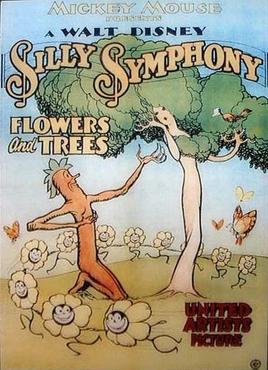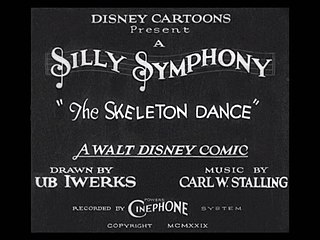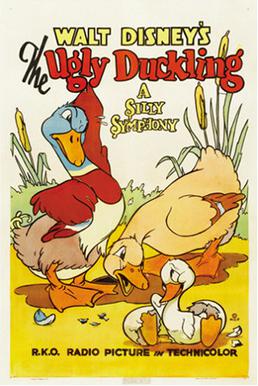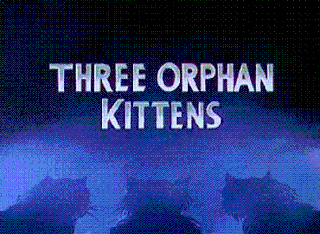
Flowers and Trees is a Silly Symphonies cartoon produced by Walt Disney, directed by Burt Gillett, and released to theatres by United Artists on July 30, 1932. It was the first commercially released film to be produced in the full-color three-strip Technicolor process after several years of two-color Technicolor films. The film was a commercial and critical success, winning the first Academy Award for Best Cartoon Short Subject.

The Skeleton Dance is a 1929 Silly Symphony animated short subject produced and directed by Walt Disney and animated by Ub Iwerks. In the film, four human skeletons dance and make music around a spooky graveyard—a modern film example of medieval European "danse macabre" imagery. It is the first entry in the Silly Symphony series. In 1993, to coincide with the opening of Mickey's Toontown in Disneyland, a shortened cover of the cartoon's music was arranged to be featured in the land's background ambiance. The short's copyright was renewed in 1957, and as a published work from 1929 it will enter the US public domain on January 1, 2025.

Babes in the Woods is a 1932 Silly Symphonies animated film.

Toby Tortoise Returns is an animated Technicolor cartoon in Walt Disney's Silly Symphonies series, directed by Wilfred Jackson. It is a sequel to the 1935 short The Tortoise and the Hare, and premiered on August 22, 1936.
Elmer Elephant is a Silly Symphony cartoon short produced by The Walt Disney Company, directed by Wilfred Jackson and released on March 28, 1936.
Music Land is a Silly Symphony animated Disney short released in 1935.

The Ugly Duckling is an animated short film by Walt Disney, based on the 1843 fairy tale "The Ugly Duckling" by Hans Christian Andersen. The film was directed by Jack Cutting and Clyde Geronimi, and released in theaters on April 7, 1939. Music was composed by Albert Hay Malotte, who was uncredited for the film. The animated short was first distributed by RKO Radio Pictures, and was shown with Love Affair.

The Tortoise and the Hare is an American animated short film part of the Silly Symphony series, released on January 5, 1935, by United Artists, produced by Walt Disney and directed by Wilfred Jackson. Based on an Aesop's fable of the same name, it won the 1934 Oscar for Best Short Subject: Cartoons. This cartoon is also believed to be one of the inspirations for Bugs Bunny by Warner Bros., who first appeared in 1940.

Three Orphan Kittens is a 1935 animated short film in the Silly Symphonies series produced by Walt Disney Productions. It was the winner of the 1935 Oscar for Academy Award for Best Short Subject (Cartoons). It was followed in 1936 by a sequel, More Kittens.
The Ugly Duckling is an animated black-and-white cartoon released by Walt Disney in 1931 as part of the Silly Symphonies series. This cartoon was later remade into a color version released in 1939, which follows the original Andersen story much more faithfully. This gives The Ugly Duckling the unique distinction of being the only Silly Symphony to be made twice. This film was then sold to reach about 4,000 dollars per month at the most profit, because it slowly climbed up the scale of growth.

King Neptune is a 1932 cartoon by Walt Disney, the second in the Silly Symphonies series produced in Technicolor. While Flowers and Trees was originally intended as a black and white cartoon, King Neptune was meant to be in colors already from the start, and was able to take full advantage of this.
Mother Pluto is a Silly Symphonies cartoon released on November 14, 1936, directed by Wilfred Jackson. The cartoon features Pluto.

Wynken, Blynken & Nod is a 1938 Silly Symphonies cartoon, adapted from Eugene Field's poem of the same name. Like other Symphonies at the time, it utilized the multiplane camera. It was directed by Graham Heid, produced by Walt Disney Productions, and distributed by RKO Radio Pictures. The three children bore similarities to Michael Darling in the 1953 Disney feature film, Peter Pan.
The Flying Mouse is a Silly Symphonies cartoon produced by Walt Disney, directed by David Hand, and released to theatres by United Artists on July 14, 1934. The use of color here was rather innovative as it is set during the course of a single day.

The Robber Kitten is a 1935 Walt Disney Silly Symphonies cartoon, directed by David Hand.
The China Plate is a 1931 Silly Symphonies animated film.
Peculiar Penguins is a Silly Symphonies animated Disney short film. It was released in 1934. The song played during the cartoon is called "The Penguin Is a Very Funny Creature", by Leigh Harline.
Lullaby Land is a Silly Symphonies animated Disney short film released in 1933. The quilt from Lullaby Land inspired the garden section of the Storybook Land Canal Boats ride at Disneyland California.

Farmyard Symphony is a 1938 Silly Symphonies animated short film. It can be seen as a precursor to Fantasia due to using various pieces of classical music in one short. The film was directed by Jack Cutting and produced by Walt Disney.

Water Babies is a Silly Symphonies cartoon released on May 11, 1935, by United Artists. The cartoon was directed by Wilfred Jackson. It features 2-inch-tall nude babies playing games in and out of the water. The babies are all completely identical other than the color of their hair. The edited version of the cartoon eliminates some shots that feature nude baby bottoms as a sight gag.












